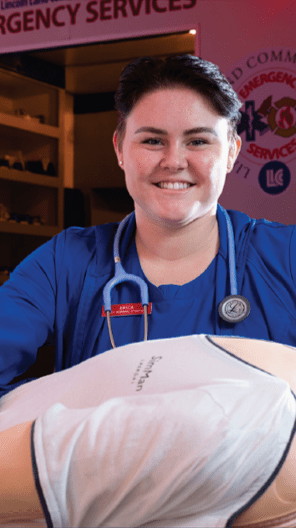
“The term Emergency Medical Services (EMS) includes all the personnel who take care of patients in first responder capacities or the prehospital setting,” says Christopher McDowell, M.D., associate professor and chair of emergency medicine, SIU School of Medicine. “These first responders and their lifesaving patient care skills are an essential part of emergency care for any community.”
Erica Bunch and Austin Bell are two graduates of LLCC’s EMS program who worked in the field and are now utilizing those skills in other, related health care fields.
Bunch graduated as an EMT but was too young at the time to work for an ambulance company.
“So I worked as a tech in the ER at HSHS St. John’s. ER techs have an expanded scope of what we can do: we receive patients from ambulances, take vitals, work in the trauma bay, do EKGs, cast splints on people and attend to psychiatric patients. During that three-year experience, I worked around nurses and decided to pursue that field. It definitely has helped to have my emergency medical skills as I progress through the nursing program.”
After turning 21, Bunch also worked part time on an ambulance crew. “When you’re training for your EMT, you learn to think on your feet. No day on the job is the same, and you’re applying the knowledge you gained every day. Helping people in their time of need, on the worst day of their lives, is a regular day for you. You have to thrive in high stress situations.”
Austin Bell graduated as an EMT in 2016 and from the LLCC registered nursing program in 2020. He is currently an R.N. in the emergency department at Springfield Memorial Hospital.
“I first enrolled in the EMT program at LLCC with intentions of joining a fire department,” says Bell. “Thanks to the required clinical time I met some fantastic staff members and gained experience that led me to apply for the emergency medical specialist position in the local emergency department. There, I was truly exposed to nursing for the first time in my life. The experience I gained in the ED gave me a ton of knowledge that gave me a great foundation to learn in the nursing program.”
As Bunch and Bell illustrate, EMTs/paramedics can work as emergency room technicians; for ambulance companies, hospitals, cities and townships; as firefighters and contract medics. EMTs learn to remain calm and be the person we look to and depend on in a crisis.
Dr. McDowell explains, “EMS providers provide lifesaving care in very difficult circumstances. They stabilize patients by making quick decisions to ensure patients arrive at the hospital already being treated. Imagine diagnosing a heart attack, treating an allergic reaction or stabilizing a severely injured motor vehicle collision victim. These are just some of the amazing things our EMS providers do every day. EMS is a truly fulfilling career where no two days are ever alike.
“Obtaining certification as an EMS provider is a great way to gain health care experience while serving the community and earning a living. EMS providers often continue to develop their careers by entering other disciplines such as fire service, nursing, flight medicine or even medical school.”
LLCC’s EMS training programs range from 16 weeks for emergency medical technician and emergency medical responder, to two years for an associate in applied science degree in emergency medical services. Advanced EMT takes 24 weeks to complete, and Paramedic, 11 months.
